1. Introduction
At present, most onshore basins in China have entered an exploration stage dominated by stratigraphic-lithologic oil and gas reservoirs. Exploration depths are gradually advancing into deep and ultra-deep layers, with reservoir types shifting from high-porosity, high-permeability clastic rocks to low-permeability and ultra-low-permeability tight sandstones, carbonates, and volcanic rocks [1]. In the development of low-permeability sandstone oilfields, significant challenges are encountered, such as high flow resistance, threshold pressure, and low natural productivity, as well as increased difficulty in identifying reservoirs and distinguishing oil and gas layers. Existing research indicates that the type and intensity of diagenesis are critical factors determining the formation and distribution of low-porosity, low-permeability reservoirs. Diagenesis not only influences the evolution of pore structures but also dictates the characteristics and distribution patterns of favorable reservoirs [2]. Thus, studying the diagenesis and diagenetic facies of tight sandstones with low to ultra-low permeability is of great significance for the efficient development of low-permeability oil and gas resources.
Well logging, characterized by its high vertical resolution, short acquisition time, strong continuity, and low cost, has become an indispensable tool in diagenetic facies research [3]. The differences in diagenetic facies caused by diagenesis are particularly evident in well log responses, making well logging increasingly important in diagenetic facies studies. Especially in the absence of core data, the integration of diagenetic facies and log data can effectively predict reservoir quality [4].
Research on the log-based identification of diagenetic facies is still in its infancy. One of the primary challenges in current research is extending point-based analyses to three-dimensional quantitative models and establishing discriminative relationships between diagenetic facies and log facies [5]. Clarifying the log response characteristics of diagenetic facies, establishing recognition models and criteria for different diagenetic facies, and using log data to infer the spatial distribution of diagenetic facies are pressing issues that need to be addressed. In light of this research status, this paper briefly introduces the definition and classification of diagenetic facies, investigates the log responses of typical diagenetic facies, and systematically summarizes previous methods and procedures for identifying diagenetic facies using well logs to analyze future development trends.
2. Definition and Classification of Diagenetic Facies
2.1. Definition of Diagenetic Facies
Diagenetic facies refer to the comprehensive results of various diagenetic processes experienced by rocks during diagenesis [6]. This concept, first introduced by Miall, was used to describe diagenetic heterogeneity in sandstone reservoirs. Diagenetic facies encompass the rock types and their characteristics formed under specific depositional environments and physicochemical conditions, influenced by diagenesis, fluid activity, and tectonic processes. While scholars have different interpretations of diagenetic facies, the core definition typically includes two aspects:
Diagenetic Environment: The geological setting where diagenesis occurs. Diagenetic Products: The integrated features of detrital grains, cement, and pores formed within this environment.
These processes and minerals determine the ultimate properties of rocks, such as cementation, compaction, and dissolution. Diagenetic facies sharing the same characteristics often exhibit similar compositional and structural attributes, matrices and cements, as well as pore systems [7].
Initially, the concept of diagenetic facies emphasized single-factor analysis. However, given the complexity of diagenetic processes and the diversity of diagenetic environments, single-factor studies often have limitations. To address this, scholars proposed the concept of “comprehensive diagenetic facies,” aiming to provide a more holistic classification by integrating multiple factors influencing diagenesis [8]. Comprehensive diagenetic facies consider factors such as diagenetic stages, mechanisms for the formation of secondary pores, and diagenetic evolution models. By synthesizing characteristics from different single-factor diagenetic facies, this approach enables a more precise classification of diagenetic facies. It facilitates a more thorough assessment of reservoir quality and provides valuable references for oil and gas exploration and development [9].
2.2. Classification and Naming of Diagenetic Facies
There are various methods for classifying diagenetic facies, often achieved through thin-section petrographic analysis, SEM, and X-ray diffraction [10]. There is no fixed standard for diagenetic facies classification, and different scholars have proposed classifications from diverse perspectives. Nevertheless, many diagenetic facies descriptions overlap in the rock types they characterize (Table 1).
When evaluating the quality of tight sandstone reservoirs and conducting well log analyses, common diagenetic facies can be categorized into six types: (1) tightly compacted facies; (2) quartz cementation facies; (3) carbonate cementation facies; (4) clay mineral filling facies; (5) clay mineral coating facies; (6) dissolution facies. Other diagenetic minerals, such as feldspar, gypsum, and pyrite, are relatively rare in sandstones and are typically not classified as separate diagenetic facies.
Table 1: Classification of Diagenetic Facies by Different Scholars
Researcher and Year | Basis for Classification | Types of Diagenetic Facies |
Carvalho et al. | Distribution patterns of carbonate cement and pseudo-matrix | Completely cemented facies, partially cemented facies, pore facies, intra-clastic facies, etc. |
Elfigih et al. | Diagenetic events | Quartz cemented facies, chlorite cemented facies, calcite cemented facies, mechanical compaction facies, chemical compaction facies, cement inhibition facies, etc. |
Aleta et al. | Mineral composition of rocks | Calcium-rich montmorillonite facies, cristobalite-rich montmorillonite facies, aragonite and high-magnesium calcite facies, low-magnesium calcite facies, etc. |
Fu et al. | Diagenesis and pore structure characteristics | Weakly compacted facies of primary and secondary pores, feldspar dissolution facies of primary and secondary pores, compacted and pressure-dissolved facies with complex pore filling, etc. |
Shi et al. | Diagenetic minerals and diagenetic processes | Weakly dissolved diagenetic facies with chlorite rims, unstable component dissolution diagenetic facies, compacted and densified diagenetic facies, etc. |
Liu et al. | Changes in porosity and reservoir properties | Granular chlorite film-weak dissolution facies, unstable component dissolution facies, tightly compacted facies, clay mineral filling facies, etc. |
3. Steps for Diagenetic Facies Identification via Logging
The evaluation of diagenetic facies through logging is based on the differences in mineral composition, pore structure, diagenetic processes, and their evolution among various diagenetic facies. These differences result in distinct responses on sensitive logging curves (e.g., resistivity, natural gamma, density, and acoustic travel time). By analyzing the response characteristics of logging curves, combined with regional geological background and core data, diagenetic facies can be accurately identified and classified.
The logging-based evaluation of diagenetic facies generally involves three fundamental steps: (1) Classification of Diagenetic Facies: Based on regional geological characteristics and analysis of thin section, scanning electron microscopy (SEM), and other data, different types of diagenetic facies are identified; (2) Response Feature Analysis: Analyze the response characteristics of various diagenetic facies on sensitive logging curves to construct a discrimination model correlating diagenetic facies with logging curves; (3) Single-well Identification: Perform diagenetic facies identification for individual wells. Combine the results with production analysis to determine the favorable types of diagenetic facies.
As research progresses, the steps for evaluating diagenetic facies through logging have become increasingly refined. The process includes: (1) Data Collection and Core Analysis: Gather logging data such as natural gamma, density, and acoustic data, and analyze core data for mineral composition, porosity, and permeability; (2) Classification of Diagenetic Facies: Using core and logging data, combined with regional geological background, classify diagenetic facies based on features such as mineral composition, pore structure, and diagenetic processes; (3) Correlation Between Core and Logging Data: Compare core data with logging data to determine the logging response characteristics corresponding to each diagenetic facies. Modern mathematical methods, such as principal component analysis (PCA), can also be employed to integrate core experimental results with logging data and establish quantitative relationship models between diagenetic facies and logging data; (4) Mapping the Spatial Distribution of Diagenetic Facies: Based on these models, draw planar distribution maps of diagenetic facies to predict the spatial distribution of favorable reservoir; (5) Dynamic Monitoring and Model Updating: Regularly update the classification and distribution models of diagenetic facies using new drilling data and production data. Perform dynamic monitoring and revision through historical data comparison and time-series data analysis to understand the temporal evolution of different diagenetic facies.
4. Logging Response Characteristics of Typical Diagenetic Facies
The definition of diagenetic facies involves the type and intensity of diagenetic processes, typically determined using logging responses (e.g., gamma ray, acoustic, and resistivity logging). In the absence of core control, these responses effectively assist in building predictive models for diagenetic facies and reservoir quality [11]. By correlating core descriptions with logging responses, the distribution of diagenetic facies in sandstone reservoirs can be predicted. Through the establishment of predictive models, this approach can further be applied to wells with similar logging characteristics to infer diagenetic facies distribution and reservoir quality [12]. This section provides a detailed analysis and summary of the logging response characteristics of typical diagenetic facies in tight sandstone reservoirs with low porosity and low permeability.
Compacted Facies - Mechanical compaction is primarily controlled by sediment composition, texture, and effective stress. Clay-rich formations generally exhibit high compaction, forming dense diagenetic facies characterized by high density, relatively high gamma ray values, and low resistivity. Fine-grained siltstone and mudstone experience significant compaction, while poorly sorted sandstone shows more pronounced compaction due to smaller grains filling the voids between larger grains. Additionally, mechanical compaction plays a critical role in thin sandstone layers (typically less than 10 cm thick) [13].
Quartz Cementation Facies - Quartz cementation facies typically have low gamma ray values and develop in sand-rich, clay-deficient formations with low compaction levels. However, extensive quartz cementation and chemical compaction result in reduced thin-section porosity. High quartz content provides a source of silica for late-stage cementation, significantly degrading reservoir quality. Logging characteristics include low gamma ray values, medium to high density, and low acoustic travel time (AC) values, indicating low porosity and permeability [14].
Carbonate Cementation Facies - Carbonate cementation facies exhibit low gamma ray (GR) values, low acoustic travel time (AC) values, low neutron porosity, and high resistivity. They are typically found in clean sandstone layers deposited in high-energy environments and are associated with mudstone layers of poorer reservoir quality. Carbonate cements (e.g., calcite, dolomite) with high matrix density significantly reduce porosity, as reflected in low derived porosity values across all porosity logging methods [15]. This facies’ increased density elevates resistivity, commonly appearing at the edges of sandstone bodies where strong water-rock interactions occur.
Clay Mineral Filling Facies - In clay mineral filling facies, quartz and carbonate cements are commonly locally precipitated, while authigenic clay minerals, such as illite, are widespread. Micropores dominate the pore system, with sizes below the resolution of thin-section petrography. Due to the conductivity of clay minerals, this facies is characterized by moderate to high gamma ray values and relatively low resistivity. Porosity logging often shows moderate to high values, indicating poor reservoir quality [16].
Clay Mineral Coating Facies - Although chlorite grain coatings occupy a small proportion of pore space, they inhibit quartz precipitation, preserving primary porosity. Their effect correlates with grain size, forming primarily in coarse-grained sandstones deposited in high-energy hydrodynamic environments. Compared to fine-grained sandstones, chlorite grain coatings effectively preserve porosity. In logging data, this facies exhibits low to moderate gamma ray values, low bulk density, high neutron porosity, and high acoustic travel time, with moderate to high resistivity, indicating good reservoir quality. It can be distinguished from clay mineral filling facies [17].
Dissolution Facies - Dissolution facies are typically associated with coarse-grained, well-sorted sandstones with low clay and cement content, where secondary dissolution pores dominate the pore system. This facies has good reservoir quality, with logging responses similar to clay mineral coating facies. It can be identified by low bulk density and moderate neutron porosity. Resistivity values are generally high, reflecting favorable hydrocarbon potential [18]. Gamma ray readings are low, and acoustic travel time values are slightly lower, as acoustic wave propagation is less sensitive to dissolution pores.
5. Logging Evaluation Methods for Diagenetic Facies and Their Advantages and Disadvantages
The logging evaluation of diagenetic facies primarily involves analyzing logging data (e.g., gamma ray, density, neutron porosity) to identify diagenetic facies, revealing the diagenetic processes, pore structures, and permeability of reservoirs. Diagenetic facies influence reservoir quality, and the logging response characteristics effectively predict porosity, permeability, and hydrocarbon potential, supporting hydrocarbon exploration and development. Since identifying diagenetic facies using a single logging curve is limited, current approaches focus on comprehensive analyses of multiple logging curves to characterize the response features of diagenetic facies, establish identification criteria, and use logging data for diagenetic facies recognition [19].
5.1. Radar Diagram Method
Also known as a spider web diagram, the radar diagram is a visual analysis method used in logging evaluation of diagenetic facies. It maps multiple logging parameters (e.g., gamma ray, density, neutron porosity, spontaneous potential) onto a radar chart, with each axis representing one logging parameter. Different diagenetic facies form distinct profiles based on their response differences in these parameters. By comparing these profiles, different diagenetic facies and reservoir characteristics can be identified [20]. For instance, in Fig. 1, Lai et al. applied the five diagenetic facies types summarized by Shi Yujiang onto six logging curves—spontaneous potential, density, compensated neutron, acoustic travel time, natural gamma, and neutron-density porosity difference—successfully identifying the diagenetic facies types of Chang 8 reservoirs in the Jiyuan region [21]. Similarly, in the deep reservoirs of the Dongying Depression, Zhang Junhua et al. combined radar diagrams with crossplots for logging data feature analysis, establishing a well-seismic interpretation template for the study area to distinguish reservoirs from non-reservoirs, thereby enhancing interpretation precision [22]. In Fig. 2, within the sandy conglomerate reservoirs of the northern Lijin area in the Dongying Depression, He Dongxu et al. defined four dimensional parameters—ΔGR, ΔAC, ΔCNL, and ΔDEN—based on the sensitivity of natural gamma (GR), acoustic travel time, neutron porosity, and density logging responses to lithology. Using radar diagram patterns under consistent radar coordinate conditions, they successfully differentiated three lithologies: conglomerate, gravelly sandstone, and gravelly muddy sandstone [23].
Radar diagrams provide a graphical display for quick and intuitive identification of diagenetic facies types. By incorporating multiple logging parameters, the analysis becomes relatively comprehensive. However, the challenge lies in the number of axes selected for analysis. Too many axes make the identification process overly complex, while too few hinder the differentiation of diagenetic facies. Additionally, selecting dimensional evaluation parameters is crucial as their sensitivity directly influences the final identification results [24]. It is worth noting that this method is highly subjective, as the contour judgments rely on the analyst’s experience, limiting its applicability. For complex geological settings, this method may face challenges in achieving sufficient resolution [25].
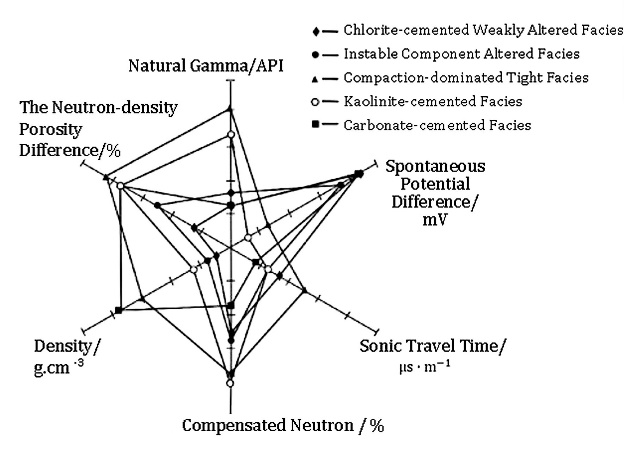
Figure 1: Spider web diagram of logging response characteristics of diagenetic facies of Chang 8 reservoirs in the Jiyuan region [26]
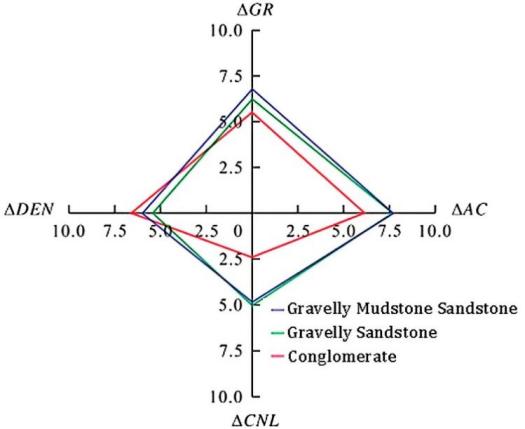
Figure 2: Radar pattern recognition modes of primary lithologies of conglomerate reservoirs [23]
5.2. Crossplot Method
The crossplot method involves plotting two or more logging data sets (e.g., gamma ray, density, neutron porosity, resistivity) on the same coordinate system to form a scatterplot. Different diagenetic facies exhibit specific distribution patterns on the crossplot, and analyzing these patterns helps identify characteristics such as diagenetic processes, porosity, and permeability. As shown in Fig. 3, Shi Yujiang et al. used a crossplot of density and the neutron-density apparent limestone porosity difference to directly distinguish between the tight compaction facies and the kaolinite-filled facies in the Chang 8 reservoir of the Jiyuan area in the Ordos Basin [21]. Similarly, Zhang Yujin used a crossplot of compaction rate and dissolution rate for different diagenetic facies to divide the diagenetic facies of the Lianggaoshan Formation in the Fuling area into five types: chlorite coating cementation and moderate compaction facies, intense dissolution of unstable components facies, carbonate strong cementation facies, strong compaction facies, and silica cementation with weak dissolution facies [27]. In Fig. 4, Wang Jinyi et al. employed a gamma ray-density (GR-DEN) crossplot to effectively distinguish three types of diagenetic facies: calcite cementation facies, dissolution facies, and compaction facies [28].
The crossplot method determines the values and ranges of sensitive parameters for different diagenetic facies based on the coordinates of intersection points, requiring a substantial number of data points for diagenetic facies as a foundation and clear boundaries among the data points on the plot. This method’s advantages include its simplicity and minimal constraints, making it widely adopted in production settings [29]. However, improper selection of crossplot parameters or low parameter accuracy may result in the loss of effective logging information and significant identification errors [30]. For tight sandstone reservoirs, the diagenetic process is often complex, and logging data for different diagenetic facies may overlap or intersect, making it difficult for the crossplot method to effectively distinguish them. Moreover, this method requires considerable manpower and time investment, increasing costs. Similar to the radar diagram method, it also faces challenges such as loss of effective information and reduced identification precision [31].
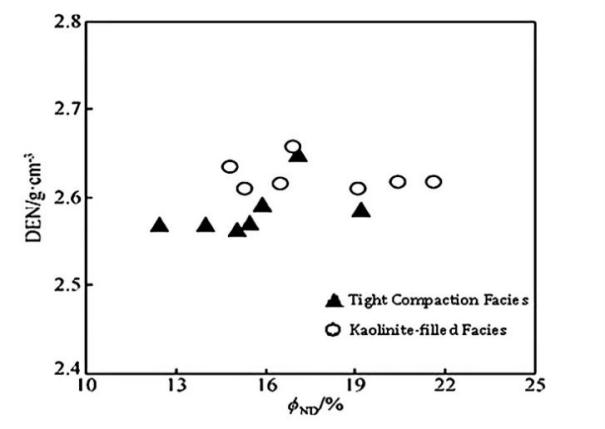
Figure 3: Crossplot of recognizing diagenetic lithofacies [21]
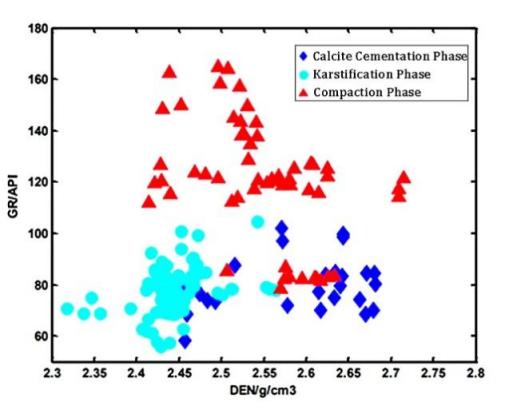
Figure 4: GR-DEN crossplot for diagenetic facies in the study area [28]
5.3. Probabilistic Neural Network Method
The probabilistic neural network (PNN) method is a neural network model based on Bayesian theory, used for the evaluation of diagenetic facies through well logging. By inputting well-logging data, such as gamma ray and resistivity, it learns the characteristic distribution of different diagenetic facies and outputs the probability values for each facies, aiding in their identification and classification. In a study of the Huagang Formation reservoirs in the central-northern anticline zone of the Xihu Depression, six well-logging parameters (GR, CNCF, DT, RD, RS, and ZDEN) were used as input layers (Fig. 5). Based on 211 training samples and 69 training iterations, a probabilistic neural network model was successfully constructed, resulting in a model that identified six types of diagenetic facies with an accuracy of 90% for the study area [32]. Similarly, Pang Guoyin et al. selected sedimentary microfacies and logging curves, such as natural gamma, borehole diameter, compensated neutron, spontaneous potential, and density, as input parameters to train and validate a probabilistic neural network for the Chang 8 reservoir of the Yanchang Formation in the Heshuo area of the Ordos Basin. The established neural network effectively predicted diagenetic facies with satisfactory results [33].
By combining “discriminant analysis” and “logistic regression,” the PNN method improves the recognition of diagenetic facies from well logging. It minimizes the loss of logging data and enhances identification accuracy, addressing shortcomings of earlier methods [34]. However, its limitations are also evident: the complexity of its application restricts large-scale promotion. In the context of tight sandstone diagenetic facies, where logging data differences are minimal, misjudgments may occur, necessitating supplementary manual analysis and correction.
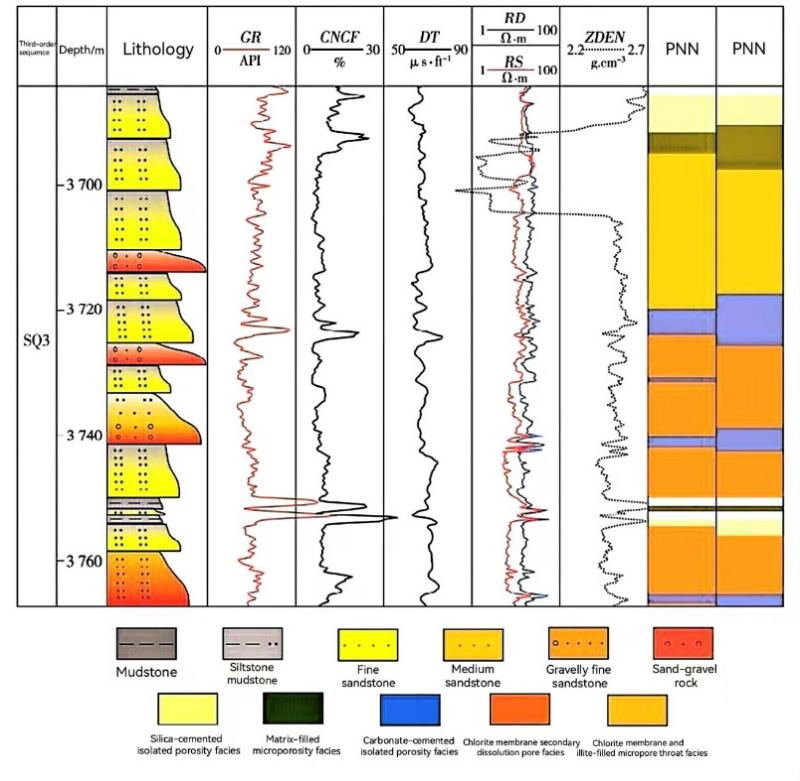
Figure 5: The diagenetic facies interpretation of the GZZ-A well [31]
5.4. Principal Component Analysis Method
The principal component analysis (PCA) method effectively reduces data dimensionality while retaining most of the information, facilitating the identification of different diagenetic facies. This method is particularly suited for handling multivariate well-logging data and can reveal underlying patterns and trends in diagenetic facies. In the Sha 3 Lower I reservoir of blocks 62-66 in the No. 5 Stake oilfield, the first four principal components extracted via transformation equations replaced the original seven logging variables to establish a diagenetic facies identification chart for the reservoir (Fig. 6). This approach achieved the goal of accurately predicting diagenetic facies [35]. Liu Aijiang et al. applied PCA in Cambrian carbonate reservoirs in the YH area, selecting principal component variables with a cumulative variance contribution rate of over 85% to construct crossplots. This method effectively identified limestone, algal dolomite, and dolomite reservoirs, overcoming difficulties in lithological identification using direct well-logging variable crossplots [36].
PCA reduces dimensionality by processing multiple logging curves and selecting principal components with high cumulative contribution rates as key variables, effectively minimizing information loss and enhancing the speed and accuracy of diagenetic facies identification [37]. Its main advantage is its broad applicability across various classification conditions without relying on specific data types. By eliminating minor information that contributes little to diagenetic facies recognition, PCA simplifies data structure, clarifying relationships. However, PCA is highly sensitive to noise and outliers, which may reduce the accuracy of dimensionality reduction results and, consequently, diagenetic facies identification precision [38]. Furthermore, the method requires a strong mathematical foundation and data preprocessing skills, particularly in standardization and principal component selection. Data scale inconsistency can also affect dimensionality reduction outcomes. In complex tight sandstone diagenetic facies, overlapping or interlacing characteristics make it challenging for PCA to extract effective principal components, thereby affecting accuracy [39].
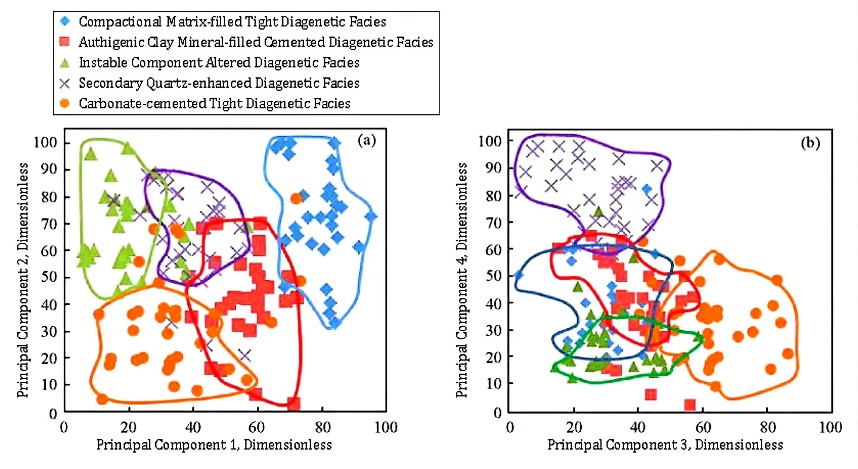
Figure 6: (a) Intersection plot of the first and second principal components; (b) Intersection plot of the third and fourth principal components[35]
6. Future Development Directions of Diagenetic Facies Identification by Well Logging
The future development of diagenetic facies identification methods using well logging mainly focuses on two aspects: first, the continuous advancement of well logging technologies, such as the application of unconventional well logging techniques like imaging logging and elemental capture logging, which expand the range of conventional well logging applications; second, the innovation of well logging data interpretation and processing methods. Future research will further explore the hidden diagenetic facies-related geological information within well logging data to improve identification accuracy.
Conventional well logging has certain limitations in evaluating pore structure in low porosity and low permeability reservoirs. Therefore, the application of unconventional well logging techniques, such as imaging logging and nuclear magnetic resonance (NMR) logging, will become increasingly important. Imaging logging can precisely identify fractured facies in fractured zones, while NMR logging helps further reveal the distribution and types of reservoir pores. Combining these advanced technologies with conventional well logging data will effectively enhance the accuracy of diagenetic facies identification [26].
Diagenetic facies are closely related to sedimentary facies, and diagenetic facies identification by well logging can draw on the mature theories and methods used in sedimentary facies analysis, such as multivariate statistical analysis and neural network technology. These techniques have already achieved significant results in sedimentary facies research and provide new ideas for the efficient identification of diagenetic facies. By utilizing these advanced data processing methods, it is possible to more accurately extract features related to lithology, composition, and grain size, further optimizing the classification of diagenetic facies [40].
7. Conclusion
Diagenetic facies are the comprehensive result of various diagenetic processes that rocks undergo during diagenesis, primarily consisting of the diagenetic environment and diagenetic products. Diagenetic facies of the same type usually exhibit similar composition and structural properties, matrix and cements, and pore systems. Due to research requirements, the concept of diagenetic facies has gradually become more integrated and comprehensive.
There are various classification methods for diagenetic facies. Based on reservoir properties and well logging analysis, combined with microscopic facies observations, six major diagenetic facies types can typically be identified in tight sandstone reservoirs: (1) tightly compacted facies; (2) quartz cementation facies; (3) carbonate cementation facies; (4) clay mineral filling facies; (5) clay mineral coating facies; (6) dissolution facies
The steps of diagenetic facies well logging identification mainly include data collection and analysis, classification of diagenetic facies types, determining response features to establish relationship models, and predicting favorable reservoirs.
In the absence of core control, well logging responses can effectively assist in building diagenetic facies and reservoir quality prediction models. By transforming diagenetic facies into reservoir quality and well logging responses, the generated models can be used to predict possible diagenetic facies, thereby predicting the reservoir quality of nearby wells with the same or similar logging responses.
Diagenetic facies well logging evaluation methods mainly include traditional evaluation methods such as crossplots and radar charts, as well as modern mathematical methods like probabilistic neural networks and principal component analysis. These methods are suitable for different environments. The development and innovation of well logging technologies, as well as the exploration and processing of well logging data, are future directions for this research. Conventional well logging has certain limitations in tight sandstone diagenetic facies identification, and the use of unconventional well logging technologies such as imaging logging will be the development trend in this field. Since diagenetic environments inherit and develop sedimentary environments, various sedimentary facies analysis methods can also be referenced for well logging identification.
References
[1]. Shi, L., Shi, D., Liao, Z., et al. (2024). Waterflooding reservoir variation in low-permeability tight sandstone reservoirs. Special Oil and Gas Reservoirs, 31(03), 106-115.
[2]. He, Q., & Zhang, J. (2022). Diagenesis and diagenetic facies of ultra-low-permeability sandstone in the Yao Yi section, southern Songliao Basin. Journal of Chengdu University of Technology (Science and Technology Edition), 49(06), 674-686.
[3]. Yin, T., Zhang, G., Cao, J., et al. (2023). A rapid method for identifying low-contrast oil layers using conventional well logging data. China Petroleum and Chemical Standards and Quality, 43(24), 157-158+161.
[4]. Huang, L., Yan, J., Liu, M., et al. (2022). Deep tight sandstone gas reservoir diagenetic facies identification and application: A case study of the Xusanjie section in the Daya area, Western Sichuan Depression. Journal of China University of Mining and Technology, 51(01), 107-123. https://doi.org/10.13247/j.cnki.jcumt.001325
[5]. Liu, H., Ai, Y., Wang, G., et al. (2023). Quantitative evaluation of diagenetic facies in deep and ultra-deep tight sandstone reservoirs: A case study of the Bohai-Zhaobei area, Kuqa Depression. Geological Science and Technology Bulletin, 42(01), 299-310. https://doi.org/10.19509/j.cnki.dzkq.2022.0256
[6]. Miall, A. D. (1996). The geology of stratigraphic sequences. Springer-Verlag.
[7]. Liu, H. (2017). Geological evaluation of tight sandstone gas reservoirs in the Taiyuan Formation in the Dingbei area, Ordos Basin (Unpublished master’s thesis). China University of Geosciences.
[8]. Xiao, G. (2022). Characterization and comprehensive evaluation of tight fractured sandstone reservoirs in the Chang 8 section, Honghe Oilfield, Ordos Basin (Unpublished doctoral dissertation). China University of Geosciences. https://doi.org/10.27492/d.cnki.gzdzu.2022.000020
[9]. Duan, X., Song, R., Li, G., et al. (2011). Comprehensive study of diagenetic facies characteristics of the Xusanjie section in the Sichuan Basin. Journal of Southwest Petroleum University (Natural Science Edition), 33(01), 7-14.
[10]. Duan, X., Song, R., Li, G., et al. (2011). Comprehensive study of diagenetic facies characteristics of the Xusanjie section in the Sichuan Basin. Journal of Southwest Petroleum University (Natural Science Edition), 33(01), 7-14.
[11]. Yu, L. (2018). Secondary interpretation of the Chang 2 reservoir in the T oilfield (Unpublished master’s thesis). Xi’an Petroleum University.
[12]. Wang, L., Liu, H., Cheng, C., et al. (2024). Progress in intelligent well log facies identification methods based on deep learning. Geophysical Prospecting, 1-16. Retrieved December 29, 2024, from http://kns.cnki.net/kcms/detail/11.2982.P.20241205.1243.076.html
[13]. Qi, N. (2021). Analysis of CO2 gas reservoir formation conditions and controlling factors in the northern Wulunshan Depression (Unpublished doctoral dissertation). China University of Petroleum (East China). https://doi.org/10.27644/d.cnki.gsydu.2021.001807
[14]. Wang, H., Ma, C., Cao, Z., et al. (2023). Diagenesis differences in tight sandstone based on lithofacies and their reservoir property response: A case study of the Lower Jurassic Sanguanghe Formation in the Mo Xizhuang area, Junggar Basin. Petroleum and Natural Gas Geology, 44(04), 976-992.
[15]. Zhong, H., Chen, L., Zhang, F., et al. (2024). Pore evolution in tight sandstone reservoirs and its impact on oil saturation: A case study of the Chang 6 to Chang 8 section of the Triassic Yanchang Formation in the Ganquan area, Ordos Basin. Petroleum Experimental Geology, 46(06), 1145-1156.
[16]. Cui, Y. (2017). Well logging characterization methods and applications for diagenetic facies in tight sandstone reservoirs (Unpublished doctoral dissertation). China University of Petroleum (Beijing).
[17]. Xie, H., Jiao, Y., Liu, Z., et al. (2020). Uranium mineral occurrence states and enrichment mechanisms in the uranium deposits of the Ordos Basin, northern China. Earth Science, 45(05), 1531-1543.
[18]. Xiao, G. (2022). Characterization and comprehensive evaluation of tight fractured sandstone reservoirs in the Chang 8 section, Honghe Oilfield, Ordos Basin (Unpublished doctoral dissertation). China University of Geosciences. https://doi.org/10.27492/d.cnki.gzdzu.2022.000020
[19]. Shi, P. (2020). Research on the interpretation methods of bedrock well logs in the ancient central uplift belt (Unpublished doctoral dissertation). Northeast Petroleum University. https://doi.org/10.26995/d.cnki.gdqsc.2020.000413
[20]. Lai, J., Wang, G., Wang, S., et al. (2013). A review and research progress of clastic rock reservoir diagenetic facies well log identification methods. Journal of Central South University (Natural Science Edition), 44(12), 4942-4953.
[21]. Shi, Y., Xiao, L., Mao, Z., et al. (2011). Identification of diagenetic facies in low-permeability sandstone reservoirs using well-logging, with geological significance - A case study from the Chang-8 reservoir in the Jiyuan area of the Ordos Basin. Petroleum Journal, 32(5), 820-828.
[22]. Zhang, J., Hu, C., Yu, Z., et al. (2021). Study of well-seismic relationships in the deep reservoir of the Dongying Sag. Progress in Geophysics, 36(4), 1651-1660.
[23]. He, D., Chen, Z., Zhang, C., et al. (2024). Well log evaluation of gravel reservoir in the Lijin North area of Dongying Depression. Oil & Gas Geology and Recovery Efficiency, 31(2), 48-57. https://doi.org/10.13673/j.pgre.202209063
[24]. Liu, C., Chen, J., & Cheng, H. (2022). Well logging evaluation technology for tight sandstone gas reservoirs in western Sichuan and its development prospects. Journal of Southwest Petroleum University (Natural Science Edition), 44(3), 59-69.
[25]. Shi, W. (2020). Study on well logging evaluation methods for shale gas reservoir gas content (Master’s thesis). Southwest Petroleum University. https://doi.org/10.27420/d.cnki.gxsyc.2020.000051
[26]. Lai, J., Wang, G., Wang, S., et al. (2013). Review and research progress of lithofacies logging identification methods for clastic rock reservoirs. Journal of Central South University, Natural Science Edition, 44(12), 4942-4953.
[27]. Zhang,Y.(2022).Identificationandevaluationofdiageneticfaciesintightsandstonereservoirsinthesoutheastern Sichuan Fuling area (Master’s thesis). China University of Petroleum (East China). https://doi.org/10.27644/d.cnki. gsydu.2022.000956
[28]. Wang, J. (2018). Response mechanisms and evaluation methods for diagenetic facies in tight sandstone reservoirs (Master’s thesis). China University of Petroleum (Beijing). https://doi.org/10.27643/d.cnki.gsybu.2018.001337
[29]. Wang, W. (2021). Numerical simulation study on diagenesis in low-permeability and tight reservoirs (Master’s thesis). China University of Petroleum (East China). https://doi.org/10.27644/d.cnki.gsydu.2021.000066
[30]. Li, J. (2016). Study on well logging evaluation technology for tight reservoirs in the Chang 8 section of the Honghe Oilfield (Master’s thesis). China University of Petroleum (East China).
[31]. Cheng, L. (2019). Study on well logging evaluation methods for high water consumption zone reservoirs (Master’s thesis). China University of Petroleum (Beijing). https://doi.org/10.27643/d.cnki.gsybu.2019.000952
[32]. Liu, M., Yang, X., Jiang, P., et al. (2019). Identification of diagenetic facies in the reservoir of the Huagang Formation in the central and northern part of the Xihu Depression using well-logging. Petroleum Geology and Engineering, 33(4), 6-10.
[33]. Pang, G., Tang, J., Wang, Q., et al. (2013). Prediction of diagenetic facies using probabilistic neural networks: A case study of the Chang 8 reservoir in the Heshui area, Ordos Basin. Special Oil & Gas Reservoirs, 20(2), 43-47, 152-153.
[34]. Bai, Y., Xue, L., Shi, Y., et al. (2013). Automatic identification of diagenetic facies from well logs and its application in the Sulige area, Ordos Basin. Journal of China University of Petroleum (Natural Science Edition), 37(1), 35-41.
[35]. Zhu, P., Lin, C., Wu, P., et al. (2015). Quantitative identification of lithofacies using principal component analysis method: A case study of the reservoir of the No. 5 pile oil field, Zhuang 62-66 block, Sha 3x I oil group. Progress in Geophysics, 35(5), 2360-2365. https://doi.org/10.6038/pg20150551
[36]. Liu, A., Zuo, L., Li, J., et al. (2013). Application of principal component analysis in lithology identification of carbonate rocks: A case study of Cambrian carbonate reservoirs in the region. Petroleum and Natural Gas Geology, 34(2), 192-196.
[37]. Li, Z. (2020). Identification of diagenetic facies in tight sandstone reservoirs of the Lower Jurassic Ahe Formation in the eastern Kuqa Depression (Master’s thesis). China University of Petroleum (East China). https://doi.org/10.27644/d.cnki.gsydu.2020.001196
[38]. Qin, B. (2018). Heterogeneity characterization of tight sandstone gas reservoirs in the Shan 1 section of the southeastern Ordos Basin (Master’s thesis). China University of Petroleum (East China). https://doi.org/10.27644/d.cnki.gsydu.2018.000893
[39]. Sun, Y. (2020). Well logging evaluation of low-permeability gravel reservoirs in the Sand 4 Upper section of the L563 block, Dongying Depression (Master’s thesis). China University of Petroleum (East China). https://doi.org/10.27644/d.cnki.gsydu.2020.001763
[40]. Li, P., Liu, Z., Chen, Y., et al. (2017). Review of well-log data application in diagenetic facies identification in low-permeability reservoirs. Geophysical Progress, 32(1), 183-190.
Cite this article
Yin,J. (2025). Overview of Log-based Identification Methods for Diagenetic Facies in Tight Sandstone Reservoirs: A Review and Research Progress. Applied and Computational Engineering,149,236-247.
Data availability
The datasets used and/or analyzed during the current study will be available from the authors upon reasonable request.
Disclaimer/Publisher's Note
The statements, opinions and data contained in all publications are solely those of the individual author(s) and contributor(s) and not of EWA Publishing and/or the editor(s). EWA Publishing and/or the editor(s) disclaim responsibility for any injury to people or property resulting from any ideas, methods, instructions or products referred to in the content.
About volume
Volume title: Proceedings of CONF-MSS 2025 Symposium: Automation and Smart Technologies in Petroleum Engineering
© 2024 by the author(s). Licensee EWA Publishing, Oxford, UK. This article is an open access article distributed under the terms and
conditions of the Creative Commons Attribution (CC BY) license. Authors who
publish this series agree to the following terms:
1. Authors retain copyright and grant the series right of first publication with the work simultaneously licensed under a Creative Commons
Attribution License that allows others to share the work with an acknowledgment of the work's authorship and initial publication in this
series.
2. Authors are able to enter into separate, additional contractual arrangements for the non-exclusive distribution of the series's published
version of the work (e.g., post it to an institutional repository or publish it in a book), with an acknowledgment of its initial
publication in this series.
3. Authors are permitted and encouraged to post their work online (e.g., in institutional repositories or on their website) prior to and
during the submission process, as it can lead to productive exchanges, as well as earlier and greater citation of published work (See
Open access policy for details).
References
[1]. Shi, L., Shi, D., Liao, Z., et al. (2024). Waterflooding reservoir variation in low-permeability tight sandstone reservoirs. Special Oil and Gas Reservoirs, 31(03), 106-115.
[2]. He, Q., & Zhang, J. (2022). Diagenesis and diagenetic facies of ultra-low-permeability sandstone in the Yao Yi section, southern Songliao Basin. Journal of Chengdu University of Technology (Science and Technology Edition), 49(06), 674-686.
[3]. Yin, T., Zhang, G., Cao, J., et al. (2023). A rapid method for identifying low-contrast oil layers using conventional well logging data. China Petroleum and Chemical Standards and Quality, 43(24), 157-158+161.
[4]. Huang, L., Yan, J., Liu, M., et al. (2022). Deep tight sandstone gas reservoir diagenetic facies identification and application: A case study of the Xusanjie section in the Daya area, Western Sichuan Depression. Journal of China University of Mining and Technology, 51(01), 107-123. https://doi.org/10.13247/j.cnki.jcumt.001325
[5]. Liu, H., Ai, Y., Wang, G., et al. (2023). Quantitative evaluation of diagenetic facies in deep and ultra-deep tight sandstone reservoirs: A case study of the Bohai-Zhaobei area, Kuqa Depression. Geological Science and Technology Bulletin, 42(01), 299-310. https://doi.org/10.19509/j.cnki.dzkq.2022.0256
[6]. Miall, A. D. (1996). The geology of stratigraphic sequences. Springer-Verlag.
[7]. Liu, H. (2017). Geological evaluation of tight sandstone gas reservoirs in the Taiyuan Formation in the Dingbei area, Ordos Basin (Unpublished master’s thesis). China University of Geosciences.
[8]. Xiao, G. (2022). Characterization and comprehensive evaluation of tight fractured sandstone reservoirs in the Chang 8 section, Honghe Oilfield, Ordos Basin (Unpublished doctoral dissertation). China University of Geosciences. https://doi.org/10.27492/d.cnki.gzdzu.2022.000020
[9]. Duan, X., Song, R., Li, G., et al. (2011). Comprehensive study of diagenetic facies characteristics of the Xusanjie section in the Sichuan Basin. Journal of Southwest Petroleum University (Natural Science Edition), 33(01), 7-14.
[10]. Duan, X., Song, R., Li, G., et al. (2011). Comprehensive study of diagenetic facies characteristics of the Xusanjie section in the Sichuan Basin. Journal of Southwest Petroleum University (Natural Science Edition), 33(01), 7-14.
[11]. Yu, L. (2018). Secondary interpretation of the Chang 2 reservoir in the T oilfield (Unpublished master’s thesis). Xi’an Petroleum University.
[12]. Wang, L., Liu, H., Cheng, C., et al. (2024). Progress in intelligent well log facies identification methods based on deep learning. Geophysical Prospecting, 1-16. Retrieved December 29, 2024, from http://kns.cnki.net/kcms/detail/11.2982.P.20241205.1243.076.html
[13]. Qi, N. (2021). Analysis of CO2 gas reservoir formation conditions and controlling factors in the northern Wulunshan Depression (Unpublished doctoral dissertation). China University of Petroleum (East China). https://doi.org/10.27644/d.cnki.gsydu.2021.001807
[14]. Wang, H., Ma, C., Cao, Z., et al. (2023). Diagenesis differences in tight sandstone based on lithofacies and their reservoir property response: A case study of the Lower Jurassic Sanguanghe Formation in the Mo Xizhuang area, Junggar Basin. Petroleum and Natural Gas Geology, 44(04), 976-992.
[15]. Zhong, H., Chen, L., Zhang, F., et al. (2024). Pore evolution in tight sandstone reservoirs and its impact on oil saturation: A case study of the Chang 6 to Chang 8 section of the Triassic Yanchang Formation in the Ganquan area, Ordos Basin. Petroleum Experimental Geology, 46(06), 1145-1156.
[16]. Cui, Y. (2017). Well logging characterization methods and applications for diagenetic facies in tight sandstone reservoirs (Unpublished doctoral dissertation). China University of Petroleum (Beijing).
[17]. Xie, H., Jiao, Y., Liu, Z., et al. (2020). Uranium mineral occurrence states and enrichment mechanisms in the uranium deposits of the Ordos Basin, northern China. Earth Science, 45(05), 1531-1543.
[18]. Xiao, G. (2022). Characterization and comprehensive evaluation of tight fractured sandstone reservoirs in the Chang 8 section, Honghe Oilfield, Ordos Basin (Unpublished doctoral dissertation). China University of Geosciences. https://doi.org/10.27492/d.cnki.gzdzu.2022.000020
[19]. Shi, P. (2020). Research on the interpretation methods of bedrock well logs in the ancient central uplift belt (Unpublished doctoral dissertation). Northeast Petroleum University. https://doi.org/10.26995/d.cnki.gdqsc.2020.000413
[20]. Lai, J., Wang, G., Wang, S., et al. (2013). A review and research progress of clastic rock reservoir diagenetic facies well log identification methods. Journal of Central South University (Natural Science Edition), 44(12), 4942-4953.
[21]. Shi, Y., Xiao, L., Mao, Z., et al. (2011). Identification of diagenetic facies in low-permeability sandstone reservoirs using well-logging, with geological significance - A case study from the Chang-8 reservoir in the Jiyuan area of the Ordos Basin. Petroleum Journal, 32(5), 820-828.
[22]. Zhang, J., Hu, C., Yu, Z., et al. (2021). Study of well-seismic relationships in the deep reservoir of the Dongying Sag. Progress in Geophysics, 36(4), 1651-1660.
[23]. He, D., Chen, Z., Zhang, C., et al. (2024). Well log evaluation of gravel reservoir in the Lijin North area of Dongying Depression. Oil & Gas Geology and Recovery Efficiency, 31(2), 48-57. https://doi.org/10.13673/j.pgre.202209063
[24]. Liu, C., Chen, J., & Cheng, H. (2022). Well logging evaluation technology for tight sandstone gas reservoirs in western Sichuan and its development prospects. Journal of Southwest Petroleum University (Natural Science Edition), 44(3), 59-69.
[25]. Shi, W. (2020). Study on well logging evaluation methods for shale gas reservoir gas content (Master’s thesis). Southwest Petroleum University. https://doi.org/10.27420/d.cnki.gxsyc.2020.000051
[26]. Lai, J., Wang, G., Wang, S., et al. (2013). Review and research progress of lithofacies logging identification methods for clastic rock reservoirs. Journal of Central South University, Natural Science Edition, 44(12), 4942-4953.
[27]. Zhang,Y.(2022).Identificationandevaluationofdiageneticfaciesintightsandstonereservoirsinthesoutheastern Sichuan Fuling area (Master’s thesis). China University of Petroleum (East China). https://doi.org/10.27644/d.cnki. gsydu.2022.000956
[28]. Wang, J. (2018). Response mechanisms and evaluation methods for diagenetic facies in tight sandstone reservoirs (Master’s thesis). China University of Petroleum (Beijing). https://doi.org/10.27643/d.cnki.gsybu.2018.001337
[29]. Wang, W. (2021). Numerical simulation study on diagenesis in low-permeability and tight reservoirs (Master’s thesis). China University of Petroleum (East China). https://doi.org/10.27644/d.cnki.gsydu.2021.000066
[30]. Li, J. (2016). Study on well logging evaluation technology for tight reservoirs in the Chang 8 section of the Honghe Oilfield (Master’s thesis). China University of Petroleum (East China).
[31]. Cheng, L. (2019). Study on well logging evaluation methods for high water consumption zone reservoirs (Master’s thesis). China University of Petroleum (Beijing). https://doi.org/10.27643/d.cnki.gsybu.2019.000952
[32]. Liu, M., Yang, X., Jiang, P., et al. (2019). Identification of diagenetic facies in the reservoir of the Huagang Formation in the central and northern part of the Xihu Depression using well-logging. Petroleum Geology and Engineering, 33(4), 6-10.
[33]. Pang, G., Tang, J., Wang, Q., et al. (2013). Prediction of diagenetic facies using probabilistic neural networks: A case study of the Chang 8 reservoir in the Heshui area, Ordos Basin. Special Oil & Gas Reservoirs, 20(2), 43-47, 152-153.
[34]. Bai, Y., Xue, L., Shi, Y., et al. (2013). Automatic identification of diagenetic facies from well logs and its application in the Sulige area, Ordos Basin. Journal of China University of Petroleum (Natural Science Edition), 37(1), 35-41.
[35]. Zhu, P., Lin, C., Wu, P., et al. (2015). Quantitative identification of lithofacies using principal component analysis method: A case study of the reservoir of the No. 5 pile oil field, Zhuang 62-66 block, Sha 3x I oil group. Progress in Geophysics, 35(5), 2360-2365. https://doi.org/10.6038/pg20150551
[36]. Liu, A., Zuo, L., Li, J., et al. (2013). Application of principal component analysis in lithology identification of carbonate rocks: A case study of Cambrian carbonate reservoirs in the region. Petroleum and Natural Gas Geology, 34(2), 192-196.
[37]. Li, Z. (2020). Identification of diagenetic facies in tight sandstone reservoirs of the Lower Jurassic Ahe Formation in the eastern Kuqa Depression (Master’s thesis). China University of Petroleum (East China). https://doi.org/10.27644/d.cnki.gsydu.2020.001196
[38]. Qin, B. (2018). Heterogeneity characterization of tight sandstone gas reservoirs in the Shan 1 section of the southeastern Ordos Basin (Master’s thesis). China University of Petroleum (East China). https://doi.org/10.27644/d.cnki.gsydu.2018.000893
[39]. Sun, Y. (2020). Well logging evaluation of low-permeability gravel reservoirs in the Sand 4 Upper section of the L563 block, Dongying Depression (Master’s thesis). China University of Petroleum (East China). https://doi.org/10.27644/d.cnki.gsydu.2020.001763
[40]. Li, P., Liu, Z., Chen, Y., et al. (2017). Review of well-log data application in diagenetic facies identification in low-permeability reservoirs. Geophysical Progress, 32(1), 183-190.









